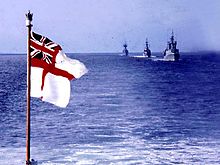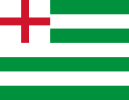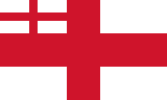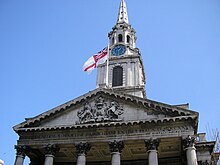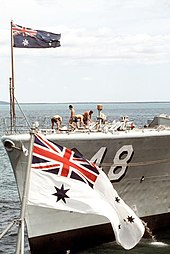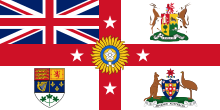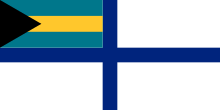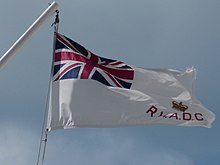
The Union Jack, or Union Flag, is the de facto national flag of the United Kingdom. Although no law has been passed making the Union Flag the official national flag of the United Kingdom, it has effectively become such through precedent. The Union Flag was also used as the official flag of several British colonies and dominions before they adopted their own national flags. The flag continues to have official status in Canada, by parliamentary resolution, where it is known as the Royal Union Flag.

The ensign is a maritime flag that is used for the national identification of a ship. The ensign is the largest flag, generally flown at the stern (rear) of the ship while in port. In ports, depending on the ship's origin, it is sometimes identical with a jack on the bow of the ship. Jacks are more common on warships than on merchant ships.

The Red Ensign or "Red Duster" is the civil ensign of the United Kingdom of Great Britain and Northern Ireland. It is one of the British ensigns, and it is used either plain or defaced with either a badge or a charge, mostly in the right half.

In British maritime law and custom, an ensign is the identifying flag flown to designate a British ship, either military or civilian. Such flags display the United Kingdom Union Flag in the canton, with either a red, white or blue field, dependent on whether the vessel is civilian, naval, or in a special category. These are known as the red, white, and blue ensigns respectively.

The flag of New Zealand, also known as the New Zealand Ensign, is based on the British maritime Blue Ensign – a blue field with the Union Jack in the canton or upper hoist corner – augmented or defaced with four red stars centred within four white stars, representing the Southern Cross constellation.
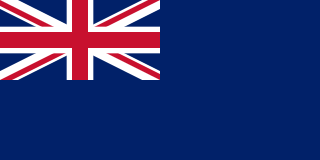
The Blue Ensign is a flag, one of several British ensigns, used by certain organisations or territories associated or formerly associated with the United Kingdom. It is used either plain or defaced with a badge or other emblem.
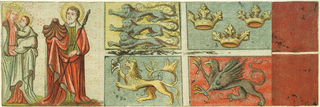
A maritime flag is a flag designated for use on ships, boats, and other watercraft. Naval flags are considered important at sea and the rules and regulations for the flying of flags are strictly enforced. The flag flown is related to the country of registration: so much so that the word "flag" is often used symbolically as a metonym for "country of registration".

In vexillography, the canton is a rectangular emblem placed at the top left of a flag, usually occupying up to a quarter of a flag's area. The canton of a flag may be a flag in its own right. For instance, British ensigns have the Union Jack as their canton, as do their derivatives such as the national flags of Australia and New Zealand.

The Royal Yacht Squadron (RYS) is a British yacht club. Its clubhouse is Cowes Castle on the Isle of Wight in the United Kingdom. Member yachts are given the suffix RYS to their names, and are permitted to wear the White Ensign of the Royal Navy rather than the merchant Red Ensign worn by the majority of other UK registered vessels. The club's patron was Queen Elizabeth II.

A jack is a flag flown from a short jackstaff at the bow (front) of a vessel, while the ensign is flown on the stern (rear). Jacks on bowsprits or foremasts appeared in the 17th century. A country may have different jacks for different purposes, especially when the naval jack is forbidden to other vessels. The United Kingdom has an official civil jack; the Netherlands has several unofficial ones. In some countries, ships of other government institutions may fly the naval jack, e.g. the ships of the United States Coast Guard and the National Oceanic and Atmospheric Administration in the case of the US jack. Certain organs of the UK's government have their own departmental jacks. Commercial or pleasure craft may fly the flag of an administrative division or municipality at the bow. Merchant ships may fly a house flag. Yachts may fly a club burgee or officer's flag or the owner's private signal at the bow. Practice may be regulated by law, custom, or personal judgment.

The current state flag of New South Wales was officially adopted in 1876. The flag is based on the defaced British Blue Ensign with the state badge located in the fly. The badge, based on the coat of arms, is a white disc with the cross of St George, a golden lion passant guardant in the centre of the cross and an eight-pointed gold star on each arm of the cross.

The Australian White Ensign is a naval ensign used by ships of the Royal Australian Navy (RAN) from 1967 onwards. From the formation of the RAN until 1967, Australian warships used the British White Ensign as their ensign. However, this led to situations where Australian vessels were mistaken for British ships, and when Australia became involved in the Vietnam War, the RAN was effectively fighting under the flag of another, uninvolved nation. Proposals were made in 1965 for a unique Australian ensign, which was approved in 1966, and entered use in 1967.

The ensign of the United States is the flag of the United States when worn as an ensign. International maritime law—see International Treaty on Law of the Sea, articles 91 and 92—provides that vessels have a "national character" and thus should display a flag (ensign) that corresponds to this national character, especially when in international or foreign waters. Vessels that are formally documented under the federal vessel documentation act, vessels owned by government bodies in the United States, and vessels in the U.S. military unquestionably have U.S. national character, and thus properly hoist a U.S. ensign to show their national character. Vessels that are numbered by the states and small, non-registered craft owned by U.S. citizens and not registered in other countries may also hoist a U.S. ensign to show their national character.

The Royal Air Force Ensign is the official flag which is used to represent the Royal Air Force. The ensign has a field of air force blue with the United Kingdom's flag in the canton and the Royal Air Force's roundel in the middle of the fly.
A civil ensign is an ensign used by civilian vessels to denote their nationality. It can be the same or different from the state ensign and the naval ensign. It is also known as the merchant ensign or merchant flag. Some countries have special civil ensigns for yachts, and even for specific yacht clubs, known as yacht ensigns.

The Star of India refers to a group of flags used during the period of the British Raj in the Indian subcontinent. India had a range of flags for different purposes during its existence. The Princely states had their own flags which were to be flown alongside the British flag as a symbol of suzerainty. The official state flag for use on land was the Union Flag of the United Kingdom and it was this flag that was lowered on Independence Day in 1947. The flag of the governor-general of India was defaced with the Star of India. The civil ensign and naval ensign were the Red Ensign or Blue Ensign, respectively, defaced with the Star of India emblem.

New England has no official flag. However, there have been many historical or modern banners used to represent the region in its history. While there are some variations, common designs include a plain colored field with a pine tree in the canton. The eastern white pine is the most common and prominent symbol of New England and is featured on many of the region's flags.

The Canadian Naval Ensign is the flag worn at the stern or at the gaff of His Majesty's Canadian Ships. The ensign is also the flag of the Royal Canadian Navy (RCN) and is used on land in this capacity.
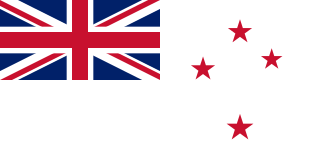
The New Zealand White Ensign is a naval ensign used by ships of the Royal New Zealand Navy (RNZN) from 1968. Based on the Royal Navy's White Ensign, it features the Southern Cross from the New Zealand national flag in place of the Saint George's Cross. One of the earliest flags associated with the country, that used by the United Tribes of New Zealand, was a white ensign. This was replaced by the Union Flag when New Zealand became a British colony. A blue ensign with the Southern Cross was introduced for ships of the colonial government in 1867 and this soon became a de facto national flag. Ships in New Zealand naval service wore the Royal Navy's White Ensign until 1968 when the distinct New Zealand White Ensign was introduced. The ensign was implemented out of a desire to distinguish New Zealand vessels from those of the Royal Navy and this decision is regarded as an important step in the development of the RNZN.



